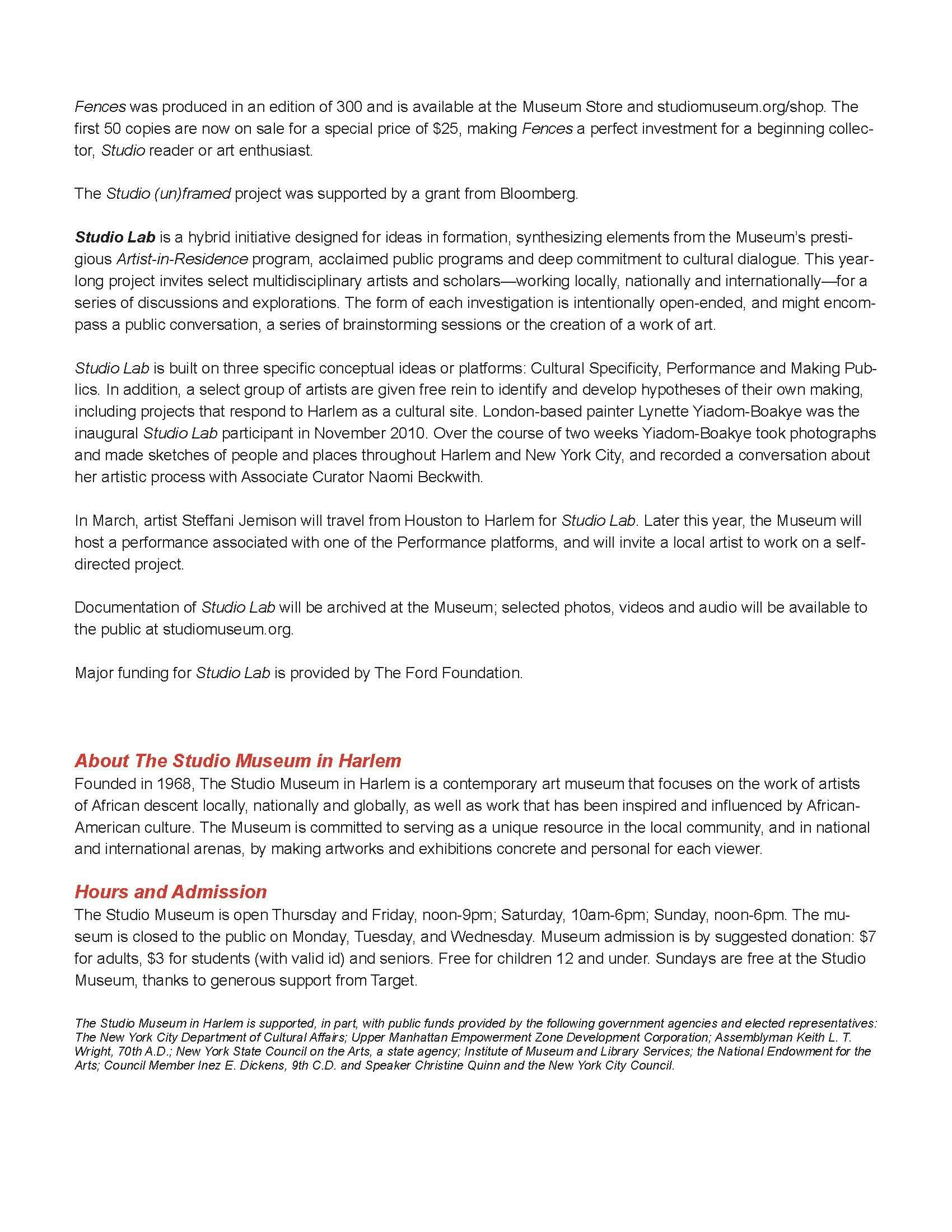History
The Studio Museum in Harlem is the nexus for artists of African descent locally, nationally, and internationally and for work that has been inspired and influenced by Black culture. It is a site for the dynamic exchange of ideas about art and society.
2033 Fifth Avenue—1968
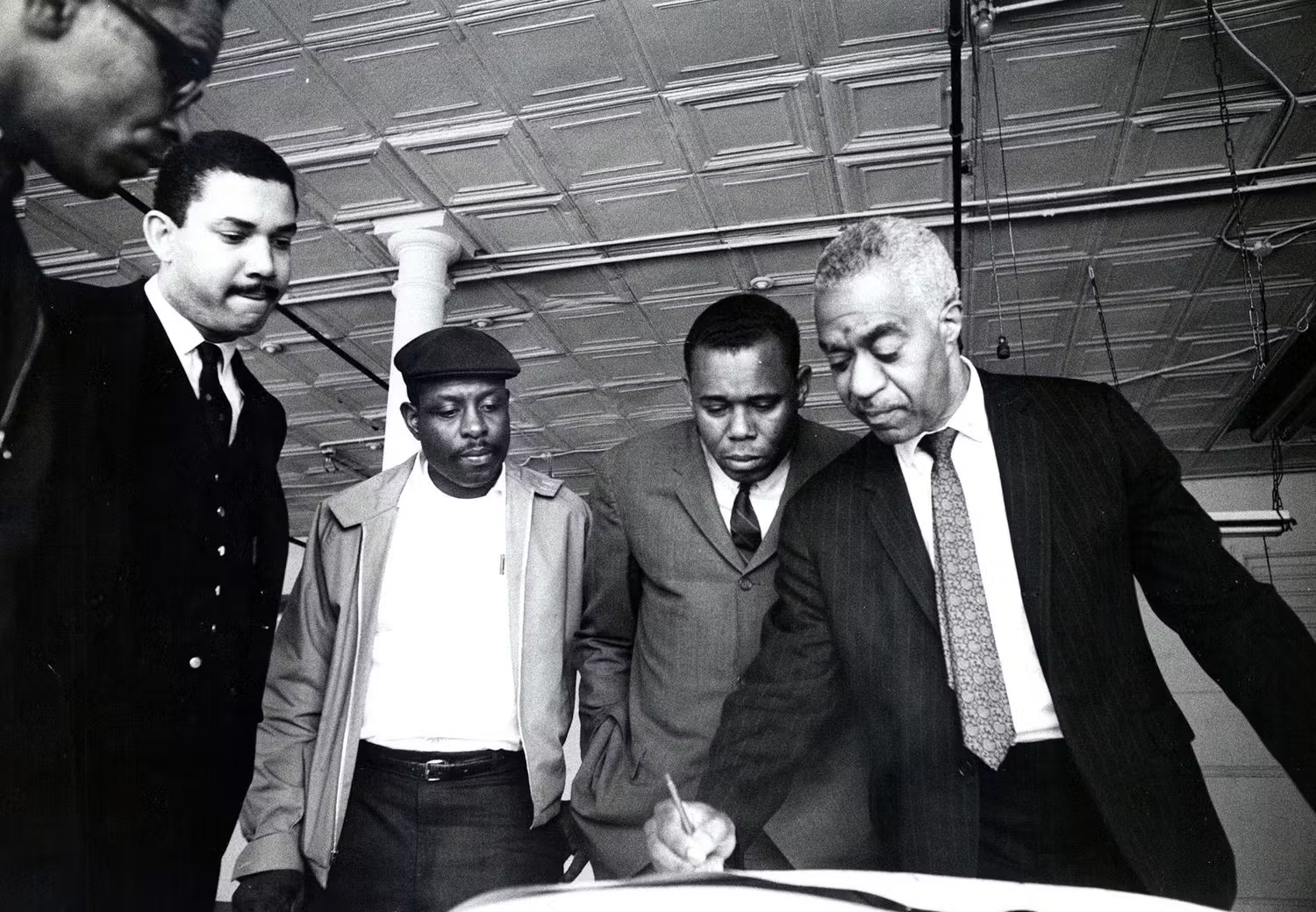
Inside the Studio Museum in Harlem's original location at 2033 Fifth Avenue, c. 1968. Photo: Reginald McGhee

Inside the Studio Museum in Harlem's original location at 2033 Fifth Avenue, c. 1968
Guided by inaugural director Charles E. Inniss, the Studio Museum secures the second floor of 2033 Fifth Ave. Under the leadership of a diverse group of artists, activists, philanthropists, and Harlem residents, the institution aims to play a crucial role in pivoting the artistic canon and making space for artists in Harlem.
Charles Inniss—1968

Charles Innis, Director, and Eleanor Holmes Norton, founding Trustee, c. 1968
Charles Inniss directs the inauguration of the Studio Museum and its programs. Inniss, a businessman previously at Dun & Bradstreet Corporation, also served as a member of the Army National Guard at its Harlem-based 369th Artillery Battalion, famously known as the Harlem Hellfighters.
The Studio Program—1968


Press release about the Museum's Studio Program, c. 1968
The Studio Program begins in 1967, with Tom Lloyd selected as the first artist. The program initially provides financial support for the creation of new works, with priority given to artists working in non-traditional materials; opportunities for young people to assist; and an exhibition.
The Film Unit—July 1968

Attendees of the Studio Museum in Harlem film workshop, c. 1968
The Film Unit, one of the first foundational programs of the Studio Museum, launches in July 1968. Directed by Randy Abbott and Rodger Larson, Director of the Young Filmmakers Foundation, the Film Unit offers free filmmaking instruction and materials to local students from Harlem and other parts of New York City.
<p>Opening Night—September 1968</p>

(L to R) Museum founders Eleanor Holmes Norton, Carter Burden, Charles E. Inniss, Campbell Wylly, Betty Blayton-Taylor, and Frank Donnelly at the Studio Museum on opening night

The original home of the Studio Museum in Harlem at 2033 Fifth Avenue, just north of 125th Street
The opening of the Studio Museum is celebrated with a ribbon cutting ceremony with director Charles E. Inniss and Museum trustees on September 24, 1968. The Museum opens to the public later that week.
September 23–October 24, 1968

Gil Noble of WABC-TV's "Like It Is" interviews Eleanor Holmes Norton, Studio Museum Trustee, before the opening of Electronic Refractions II in September 1968 at the Studio Museum in Harlem on 2033 5th Avenue
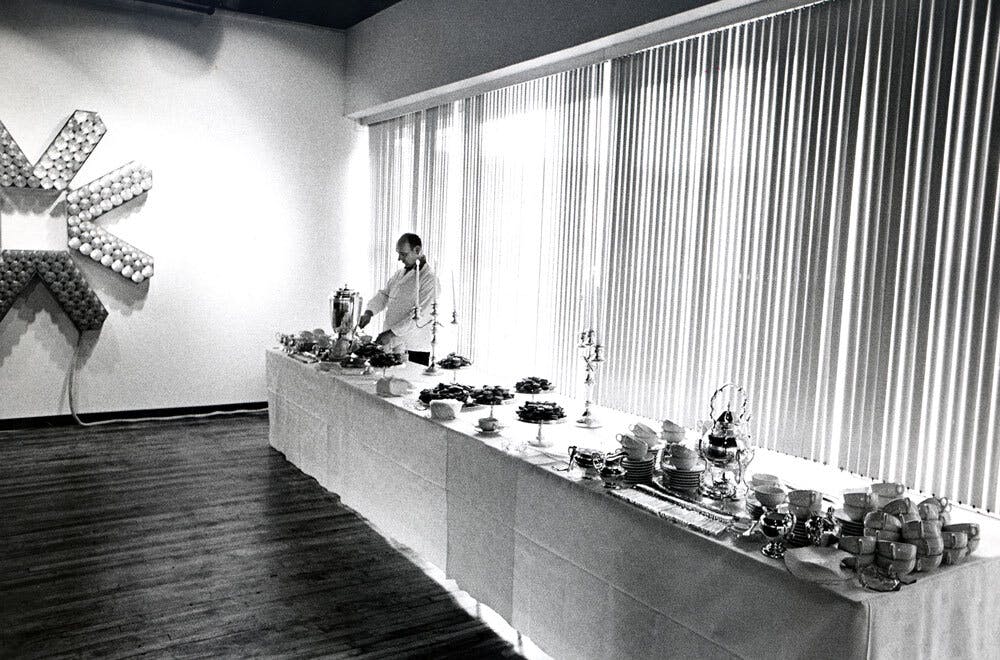
View of the September 1968 opening of Electronic Refractions II, the inaugural exhibition at the Studio Museum's first home at 2033 Fifth Avenue

Tom Lloyd, Eleanor Holmes Norton, and others at the opening of Electronic Refractions II, 1968
The Museum’s first exhibition, Electronic Refractions II, features the work of Tom Lloyd. His sculptures embrace abstraction and technology at a time when Black artists are expected to create representational work.
Edward S. Spriggs—July 1969

Studio Museum director Edward S. Spriggs, July, 1969 at the Studio Museum in Harlem on 2033 5th Avenue. Photo: Pictorial Enterprise
Edward S. Spriggs, a poet, painter, and filmmaker, is named the second director of the the Museum; he will head the institution from 1969 to 1975. Under Spriggs’s leadership, the institution develops exhibitions on artists such as Henry Ossawa Tanner and pushes for the Museum to become a site of community engagement.
The Black Masters series—1974

Cover of catalogue for Beauford Delaney: A Retrospective, 1978

Cover of catalogue for Hale Woodruff: 50 Years of His Art, 1979
The Black Masters series is conceived to rectify the systemic historic absence of Black artists from the art historical canon. Exhibitions include major solo presentations of the work of Beauford Delaney (1978) and Hale Woodruff (1979).
Courtney Callender—1975

Portrait of Courtney Callender, c. 1975
Courtney Callender is named the third director of the Studio Museum. As the institution outgrows its space at 2033 Fifth Avenue, Callender works tirelessly to keep the Museum close to its mission of serving the surrounding arts community by continuing programming that focuses on strengthening diasporic connections.
The Fine Art of Collecting—November 12, 13, and 14, 1976

Brochure for Recent Acquisitions and Notables and The Fine Art of Collecting I, 1985
The Fine Art of Collecting seminar launches as a forum for artists, collectors, gallery owners, curators, and scholars to exchange information on collecting Black art. Topics include how to purchase and bequeath art, and insurance considerations. Its inaugural session hosts studio visits with many prominent Black artists.
Mary Schmidt Campbell—1977

Portrait of Mary Schmidt Campbell, c. 1983. Photo: Dawoud Bey
Scholar and curator Mary Schmidt Campbell is named Director. Campbell oversees the Museum’s move from above a liquor store at 2033 Fifth Avenue to its current location at 144 West 125th Street in the early 1980s. The new, larger space allows the Museum to accommodate expanded exhibitions, programming, and storage.
144 West 125th Street—1979


Groundbreaking for the Studio Museum in Harlem on May 20, 1981 at 144 West 125th St. (L to R) Carl McCall, Mary Schmidt Campbell, Arthur Barnes, Robert Carroll, and Fred Samuel.
The Museum is gifted the building at 144 W. 125th St., the former site of the New York Bank of Savings. Celebrated Black architect J. Max Bond Jr. is selected to renovate the site to suit the needs of a pioneering museum.
June 20–November 1, 1982

Cover of Ritual and Myth: A Survey of African American Art brochure

Ritual and Myth: A Survey of African-American Art (installation view) at the Studio Museum in Harlem, 1982
Ritual and Myth: A Survey of African American Art is the first exhibition installed in the Studio Museum’s West 125th Street location. The exhibition assembles over seventy works by forty-five artists, spanning African art to contemporary installation.
Major building renovations—1985

Exterior of the Studio Museum in Harlem at 144 West 125th St., c. 1993. Photo: Sherman Bryce
Excavation of an adjacent vacant lot at 142 West 125th Street, leased from the City of New York, begins. Over the following two decades, the Museum, in partnership with the City, completes further renovations to the building and lot, adding an additional gallery and lobby space, a theater, and flexible outdoor space.
January 27–June 30, 1985

Cover of catalogue for Tradition and Conflict: Images of A Turbulent Decade, 1963–1973, 1985
Including 150 works by fifty-five artists, Tradition and Conflict: Images of a Turbulent Decade, 1963–1973 marks one of the most ambitious exhibitions ever mounted by the Studio Museum, as it presents the artistic achievements and importance of Black artists during a ten-year period.
February 23–June 12, 1986

Cover of brochure for The Hale Woodruff Memorial Exhibition: Emerging Artists from the Southwest, 1986
The Studio Museum inaugurates the Hale Woodruff Memorial Exhibition series, designed to provide exhibition opportunities for a national group of emerging and underknown Black artists, with Emerging Artists from the Southwest.
Kinshasha Holman Conwill—August 7, 1988

Kinshasha Holman Conwill serves as Director from 1988 to 1999. As Director, she supervises continued renovation of the Museum’s building and helps transform the new space into a vibrant place of community growth, a forum for discussion, and a center of creativity and imagination.
January 21–May 6, 1990

Contemporary African Artists: Changing Tradition (installation view) at the Studio Museum in Harlem, 1990
After three years of research in Africa and the US, Contemporary African Artists: Changing Tradition, featuring the work of nine artists from six African countries, opens. A version of the show is exhibited at the 1990 Venice Biennale, marking the first official inclusion of contemporary African artists at that venue.
May 19–August 8, 1990

The Decade Show: Frameworks of Identity in the 1980s (installation view) at the Studio Museum in Harlem, 1990

The Decade Show: Frameworks of Identity in the 1980s (installation view) at the Studio Museum in Harlem, 1990
The Decade Show: Frameworks of Identity in the 1980s opens. The exhibition is a collaboration with the New Museum for Contemporary Art and Museum of Contemporary Hispanic Art and brings together works by ninety-four artists of Hispanic, Asian, African-American, Native American, and European heritage.
September 12, 1993–July 3, 1994

Cover of the brochure for The 25th Anniversary Exhibition: Recent Acquisitions and Selected Works From The Studio Museum in Harlem Collection, 1993
The 25th Anniversary Exhibition: Recent Acquisitions and Selected Works from the Studio Museum in Harlem Collection Part I celebrates the twenty-fifth anniversary of the Museum and is comprised largely of works that entered the collection in the 1990s, deemed the “Decade of Collecting” at the institution.
September 15, 1995–October 27, 1996
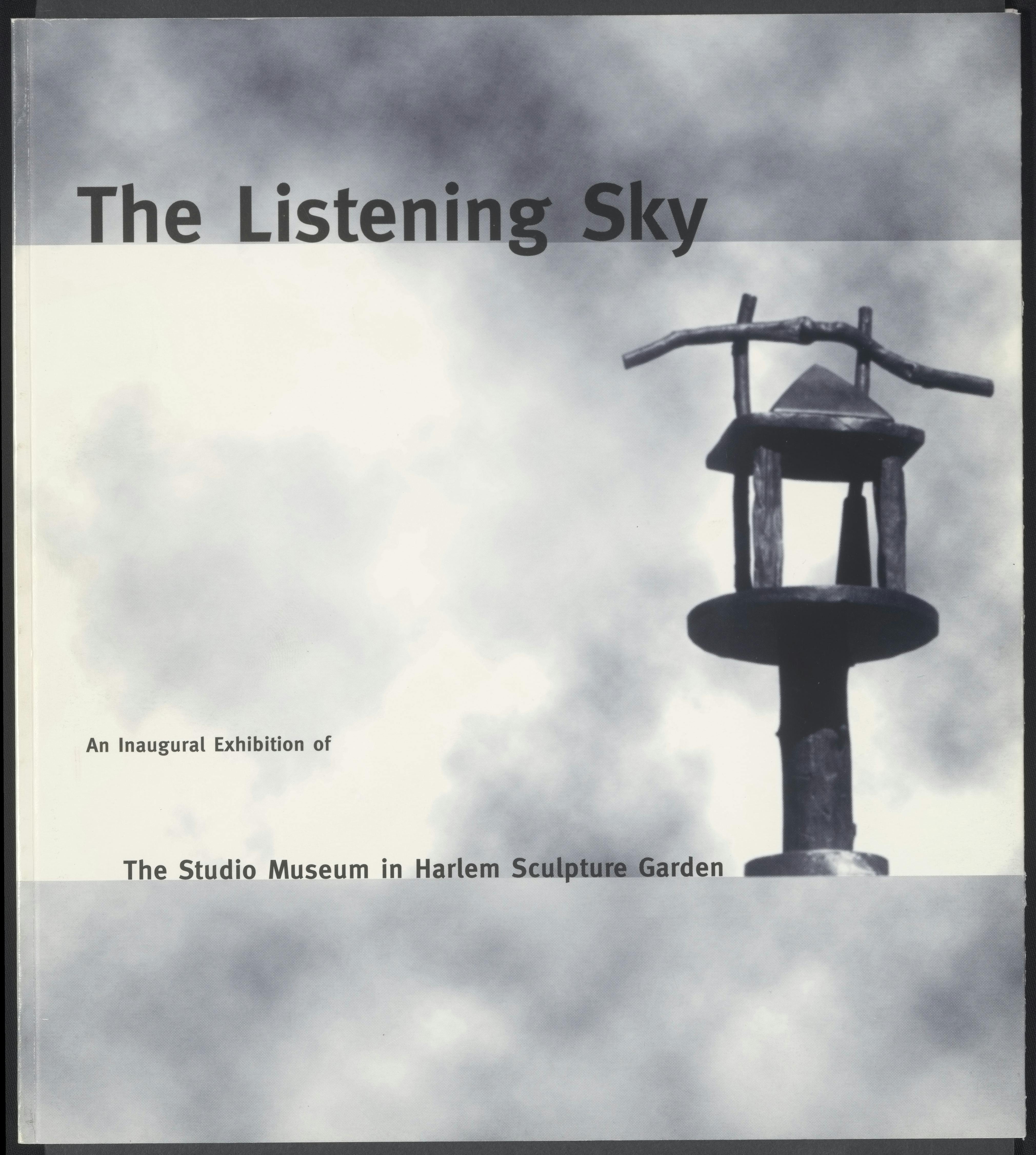
Cover of the brochure for The Listening Sky, 1995
The Listening Sky: An Inaugural Exhibition of The Studio Museum in Harlem Sculpture Garden, featuring the work of twelve artists, marks the opening of the first public space dedicated to the exhibition of outdoor sculpture by artists of African descent.
Lowery Stokes Sims—2000

Lowery Stokes Sims
Lowery Stokes Sims becomes Director with Thelma Golden as Deputy Director for Exhibitions and Programs. In focusing on the scholarly interests and growth of the institution, Sims dedicates her time at the Museum to cultivating a new generation of Black artists by implementing radical community programming.
Expanding the Walls—2000

Expanding the Walls participants, 2001
Expanding the Walls: Making Connections Between Photography, History, and Community launches as an annual program for New York City youth enrolled in a high school or GED program to learn the techniques and history of photography.
Uptown Fridays—2000

Visitors to the Studio Museum for Uptown Fridays on July 27, 2018

Flyer for Uptown Fridays, July 26, 2013
Uptown Fridays begins. This summer event invites visitors to dance in the Museum’s courtyard, browse the galleries, and attend curatorial talks. Uptown Fridays are presented with exhibitions on view and allow writers, scholars, and critics to share conversation.
April 28–June 24, 2001

Cover of Freestyle (New York: The Studio Museum in Harlem, 2001)

Freestyle (installation view) at the Studio Museum in Harlem, 2001. Photo: Adam Reich
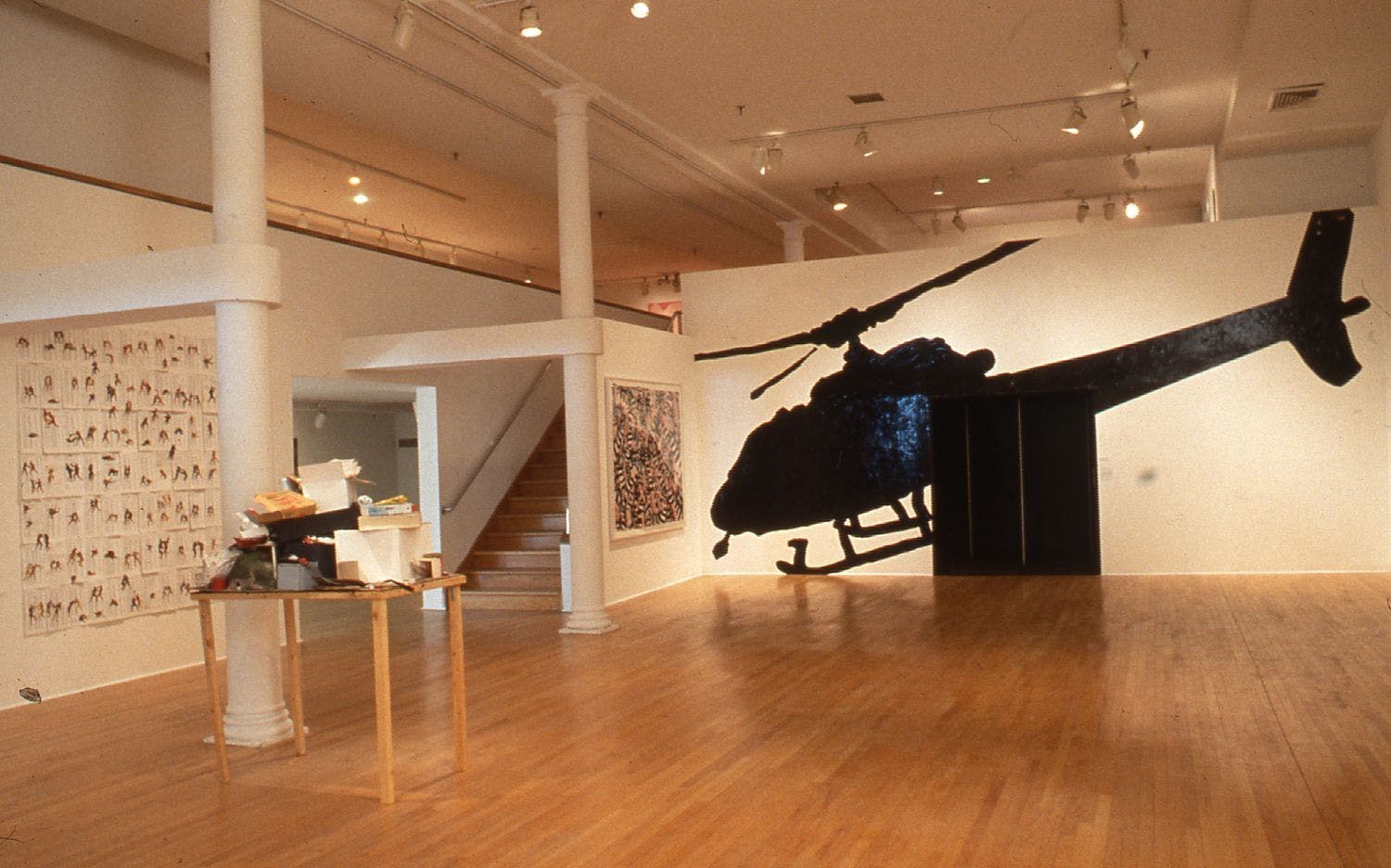
Freestyle (installation view) at the Studio Museum in Harlem, 2001. Photo: Adam Reich
Organized by Thelma Golden with Christine Y. Kim, Freestyle, the first of the "F" Shows exhibiting the work of emerging artists of African descent, opens. The Museum mounts four additional exhibitions, which become landmarks of contemporary art.
October 9, 2002
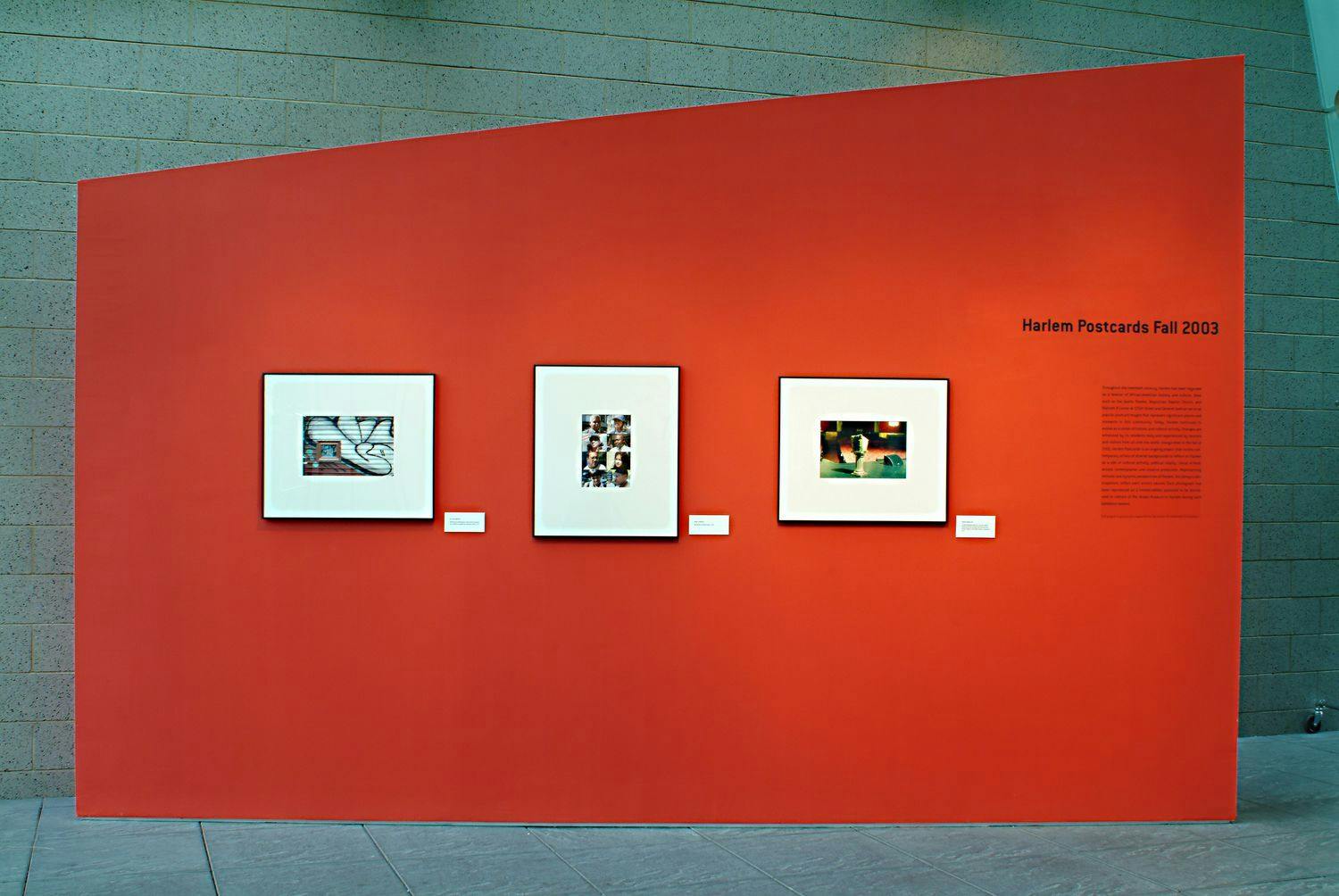
Harlem Postcards: Fall 2003 (installation view) at the Studio Museum in Harlem, 2003
Harlem Postcards, an ongoing project consisting of limited-edition postcards, launches. This series invites artists of diverse backgrounds to reflect on Harlem as a site of cultural significance, creative production, and artistic contemplation.
April 11, 2004

StudioSound: Afrikya Volume 1: A Magical Journey through Africa (installation view) at the Studio Museum in Harlem, 2006
StudioSound, a series that invites musicians, producers, and musical innovators to create original compositions inspired by the art on view, launches. This commissioned project adds a parallel dimension to the Museum’s permanent collection and exhibitions.
Thelma Golden—2005

Thelma Golden. Photo: Julie Skarratt
Thelma Golden is named Director and Chief Curator after previously being a Curatorial Intern (1987) and Deputy Director for Exhibitions and Programs (2000–2005). Her tenure is characterized by a deep commitment to advancing the work of contemporary artists and the stewardship of the Museum’s expansion with its new building.
David Hammons Flag—2005

David Hammons's Untitled (2004). Photo: Ray Llanos
The Museum installs David Hammons's Untitled (2004) outside of its building. The work combines the Pan-African colors with the pattern of the United States flag to evoke a conversation about the country's deeply racialized and oppressive history.
The Joyce Alexander Wein Artist Prize—Fall 2006

George and Joyce Alexander Wein
Created by jazz impresario, musician, and philanthropist George Wein to honor his late wife, Joyce Alexander (1928–2005), a long-time Trustee of the Studio Museum, the first Wein Artist Prize is presented to Lorna Simpson.
Fall 2008–9

Expanding the Museum’s engagement with digital and new media practices, VideoStudio, a series of video and time-based art, launches. This program focuses on emergent projects and reflects the influence of recent technology on contemporary art.
Target Free Sundays—2009
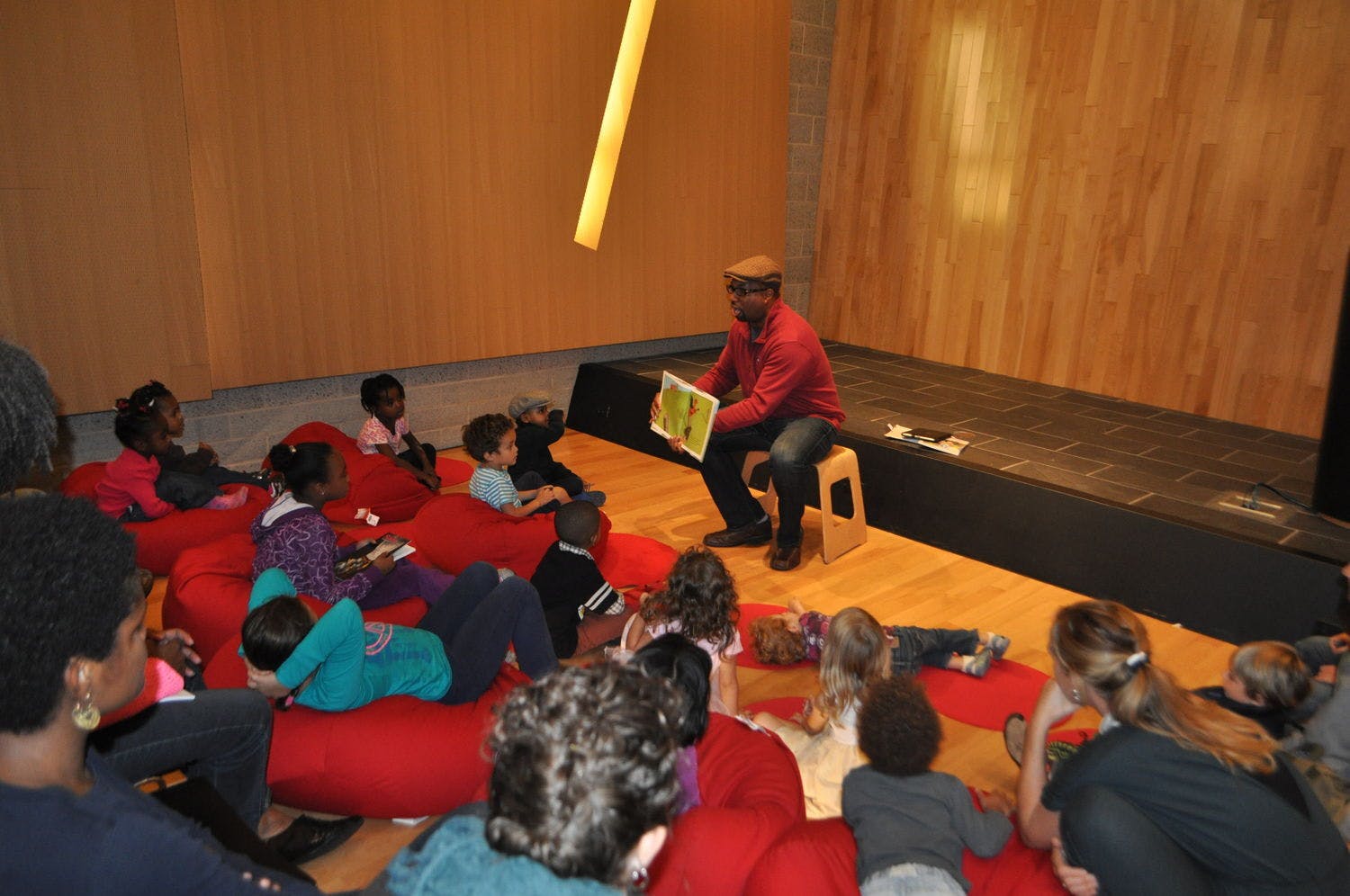
Artist and illustrator Kwame Alexander reads from his book Acoustic Rooster as part of Target Free Sundays on October 7, 2012

Participants during the Children's Book Festival during Target Free Sundays on June 1, 2014

Zachary Fabri performing in response to Marc Andre Robinson: Twice Told at the Studio Museum in Harlem as part of Target Free Sundays on March 6, 2016
Target Free Sundays arrives at the Studio Museum, providing visitors free admission to the Museum and access to a number of activities designed for family engagement. These activities include gallery tours, artist talks, and art-making workshops, among other special monthly events.
January 31, 2011
Studio Lab, a program built on the concepts of cultural specificity, performance, and making publics, launches. The series offers selected artists freedom to develop these concepts, including making projects that respond to Harlem as a cultural site.
October 11, 2011

The Bearden Project (installation view) at the Studio Museum in Harlem, 2011. Photo: Adam Reich

The Bearden Project: Spring 2012 (installation view) at the Studio Museum in Harlem, 2012

The Bearden Project (installation view) at the Studio Museum in Harlem, 2011. Photo: Adam Reich
The Studio Museum announces The Bearden Project, a dynamic exhibition initiative that invites one hundred artists to create new works of art inspired, influenced, or informed by the work and legacy of Romare Bearden, one of the most important artists of the twentieth century, in celebration of the centennial of his birth.
June 14, 2012–October 21, 2012

Organized by El Museo del Barrio, the Queens Museum of Art, and the Studio Museum, Caribbean: Crossroads of the World comprises over five hundred works spanning four centuries. It interrogates the relationship between the Caribbean and United States by including artists from both locales.
February 12, 2014

A conversation between Director and Chief Curator Thelma Golden and artist Glenn Ligon. The conversation illuminates two centennial exhibitions: Contact: Gordon Parks, Ralph Ellison and “Invisible Man,” which was presented at Howard Greenberg Gallery from September 14 to October 27, 2012 and Gordon Parks: A Harlem Family 1967, on view at the Studio Museum through March 10, 2013.
The Studio Museum in Harlem and the Schomburg Center for Research in Black Culture announce a major collaboration honoring the 100th anniversary of the birth of Ralph Ellison. Ellison at 100: Reading Invisible Man includes a year of programs and initiatives celebrating the Ellison Centennial.
Studio Museum and Museum of Modern Art (MoMA) Fellowship—2015

First cohort of the Studio Museum/MoMA fellowship program, 2015–2017. (L to R): Henry Murphy, Adeze Wilford, Dessane Cassell, Alexis Gonzalez. Photo: Alani Bass
The Studio Museum and the Museum of Modern Art develop a joint two-year fellowship program aimed at mentoring and diversifying the next generation of museum curators and professionals.
June 24, 2016

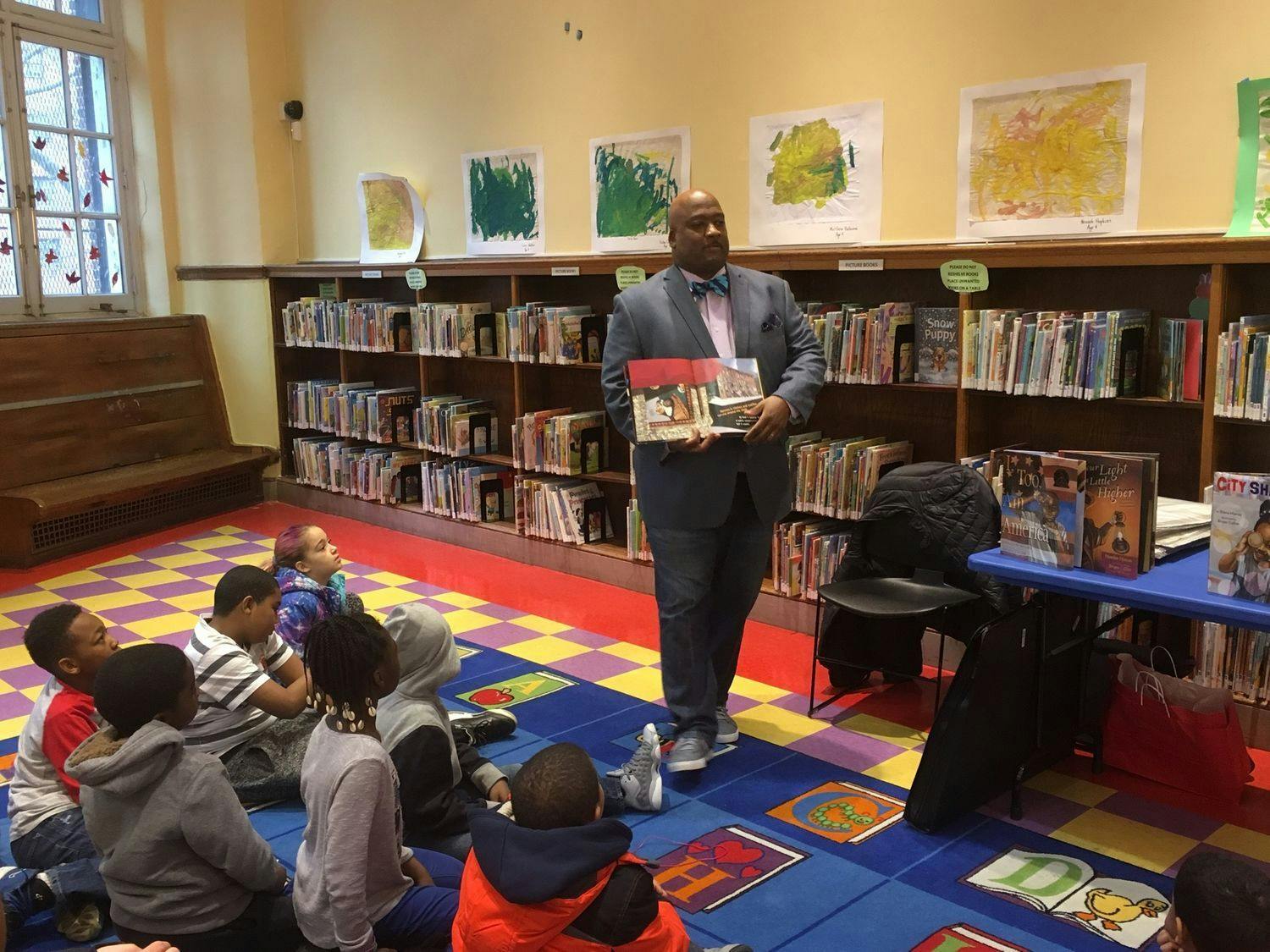
Children's book illustrator Bryan Collier presents an interactive storytelling of his book City Shapes as part of Book, Authors & Kids, a one-hour program that connects story-telling, literacy, and visual art, on July 10, 2016. The program is cited at George Bruce Library as part of inHarlem

Families come together in Marcus Garvey Park to make artwork in response to the inHarlem project Maren Hassinger: Monuments, 2019

Rachell Morillo, Jamila Lyiscott, and Quenell Jones in conversation following a screening of Hustlers Convention (2015) as part of Studio Screen, February 19, 2017. The program is presented at Maysles Cinema as part of inHarlem
The Studio Museum announces inHarlem, a new set of initiatives built upon three critical institutional pillars: artists’ projects, the permanent collection, and collaboration. In partnership with civic and cultural organizations in the neighborhood, inHarlem encompasses a wide range of artistic and programmatic ventures.
August 25, 2016

Simone Leigh, A particularly elaborate imba yokubikira, or kitchen house, stands locked up while its owners live in diaspora (installation view), 2016. Marcus Garvey Park, New York, NY, August 25, 2016–July 25, 2017. Photo: Adam Reich

Kevin Beasley, Who’s Afraid to Listen to Red, Black and Green? (detail), 2016. Morningside Park, New York, NY, August 25, 2016–July 25, 2017. Photo: SaVonne Anderson

Rudy Shepherd, Black Rock Negative Energy Absorber (installation view), 2016. Jackie Robinson Park, August 25, 2016–July 25, 2017

Kori Newkirk, Sentra (installation view), 2016. St. Nicholas Park, New York, NY, August 25, 2016–July 25, 2017. Photo: Adam Reich
Exhibitions as part of the new inHarlem initiative open. inHarlem: Kevin Beasley, Simone Leigh, Kori Newkirk, Rudy Shepherd is organized in partnership with the NYC Parks along with the Marcus Garvey Park Alliance.
New Building Project—Fall 2018
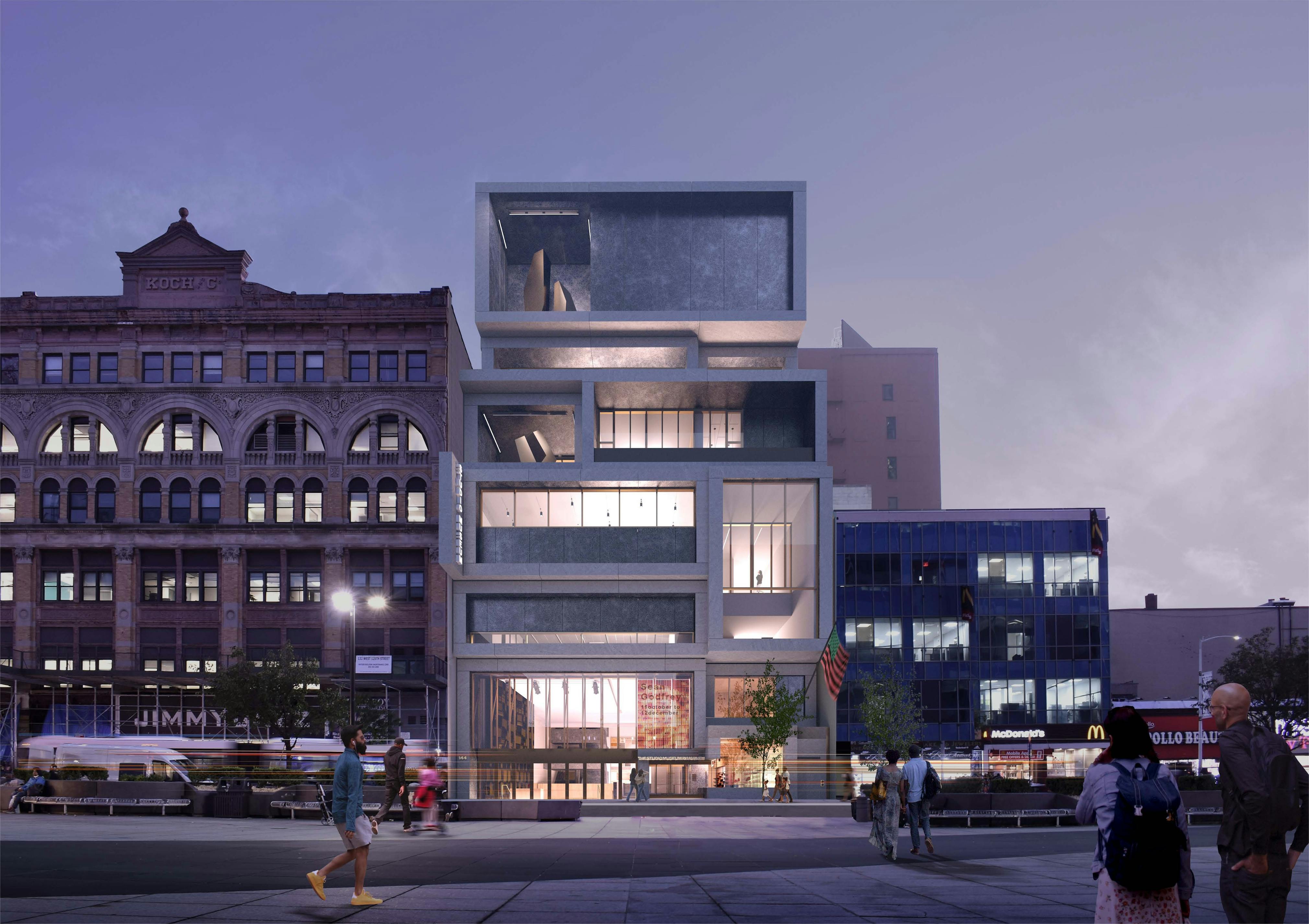

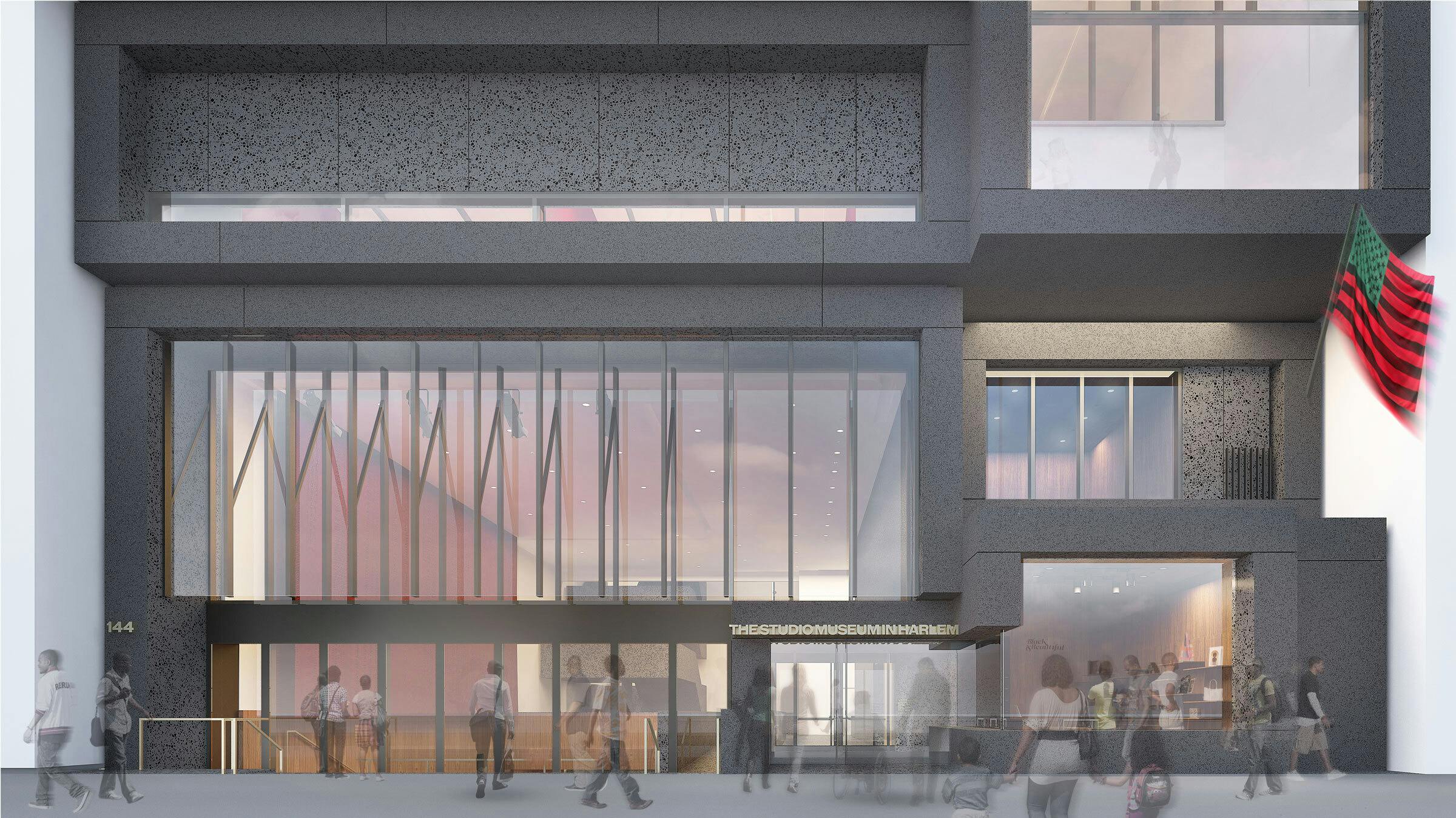
After closing its J. Max Bond Jr. building to the public in January 2018, the Museum begins the work toward its new home in Fall 2018. The design of the building, created for the needs of the institution and its surrounding communities, takes its inspiration from local architecture and the bustling Harlem sidewalks.
Peggy Cooper Cafritz Bequest—2018

Simone Leigh, No Face (Black), 2015. Terra cotta, colored porcelain, and epoxy. Studio Museum in Harlem; bequest of Peggy Cooper Cafritz (1947–2018), Washington, D.C. collector, educator, and activist 2018.40.176

Samuel Levi Jones, Inclusion, 2016. Encyclopedia and law book covers on canvas. Studio Museum in Harlem; bequest of Peggy Cooper Cafritz (1947–2018), Washington, D.C. collector, educator, and activist 2018.40.128

Titus Kaphar, Lost in Shadows, 2014. Oil on canvas. Studio Museum in Harlem; bequest of Peggy Cooper Cafritz (1947–2018), Washington, D.C. collector, educator, and activist 2018.40.145
Arts patron, educator, and civil rights activist Peggy Cooper Cafritz (1947–2018) donates the largest gift of contemporary art by artists of African descent. Over four hundred works from her collection go to the Studio Museum, and over two hundred fifty to the Duke Ellington School of the Arts.
January 15, 2019–August 15, 2021

Black Refractions: Highlights from The Studio Museum in Harlem (installation view) at The Utah Museum of Fine Arts, Salt Lake City, UT, January 23, 2021–April 10, 2021. Organized by the American Federation of Arts and the Studio Museum in Harlem. Image courtesy of The Utah Museum of Fine Arts.

Black Refractions: Highlights from The Studio Museum in Harlem (installation view) at Kalamazoo Institute of Arts, MI, September 13–December 8, 2019. Organized by the American Federation of Arts and the Studio Museum in Harlem. Image courtesy of Kalamazoo Institute of Arts

Black Refractions: Highlights from The Studio Museum in Harlem (installation view) at Smith College Museum of Art, Northampton, MA, January 17–April 12, 2020. Organized by the American Federation of Arts and the Studio Museum in Harlem. Image courtesy of Smith College Museum of Art
The Studio Museum partners with the American Federation of Arts to present Black Refractions: Highlights from The Studio Museum in Harlem, a major traveling exhibition of over one hundred works by nearly eighty artists from the 1920s to the present.
June 9–September 8, 2019

Installation view of MOOD: Studio Museum Artists in Residence 2018-19, on view at MoMA PS1, New York, June 9–September 8, 2019. Image courtesy MoMA PS1. Photo: Matthew Septimus

Installation view of MOOD: Studio Museum Artists in Residence 2018-19, on view at MoMA PS1, New York, June 9–September 8, 2019. Image courtesy MoMA PS1. Photo: Odette Chavez-Mayo

Installation view of MOOD: Studio Museum Artists in Residence 2018-19, on view at MoMA PS1, New York from June 9–September 8, 2019. Image courtesy MoMA PS1. Photo: Matthew Septimus
While the Museum is closed for construction, MoMA PS1 hosts the Studio Museum’s annual Artist-in-Residence exhibitions as a facet of the multiyear partnership between MoMA, MoMA PS1, and the Studio Museum. MOOD: Studio Museum Artists in Residence 2018–19 is the first exhibition of this collaboration.
October 21, 2019–January 20, 2020

Installation shot of Projects 110: Michael Armitage at MoMA (2019). Digital Image © 2019 The Museum of Modern Art, New York. Photographed by Heidi Bohnenkamp
MoMA and the Studio Museum partner on collaborative exhibitions for MoMA’s Elaine Dannheisser Projects Series. The first installment of the collaboration, Projects 110: Michael Armitage, is organized by Thelma Golden, Director and Chief Curator, with Legacy Russell, Associate Curator, Exhibitions.
October 26, 2021

Top row (L to R): Theaster Gates, Yaw Agyeman, Sir David Adjaye, Mayor Bill de Blasio, Studio Museum Board Chair Raymond J. McGuire. Bottom row (L to R): Studio Museum Director and Chief Curator Thelma Golden, First Lady Chirlane McCray, Commissioner of Cultural Affairs Gonzalo Casals, Studio Museum Board Vice-Chair Carol Sutton Lewis, Manhattan Borough President Gale Brewer. Photo: Julie Skarratt
The Studio Museum, joined by civic leaders, artists, patrons, and members of the vibrant Harlem community, presents Creating Space, a ceremony marking the next phase in constructing the Museum’s home on West 125th Street.
James Van Der Zee Archive—December 7, 2021

James Van Der Zee, Musical Trio, 1938. Gelatin silver print. James Van Der Zee Archive, The Metropolitan Museum of Art; print from the shared collection of The Studio Musuem in Harlem and The Metropolitan Museum of Art, 2021. © James Van Der Zee Archive, The Metropolitan Museum of Art

James Van Der Zee, "Oh Promise Me", 1925. Gelatin silver print. James Van Der Zee Archive, The Metropolitan Museum of Art; print from the shared collection of The Studio Musuem in Harlem and The Metropolitan Museum of Art, 2021. © James Van Der Zee Archive, The Metropolitan Museum of Art
The Metropolitan Museum of Art in partnership with the Studio Museum announces the establishment of the James Van Der Zee Archive, a collaborative initiative to catalogue, research, conserve, and make accessible the holdings of photographer James Van Der Zee (1886–1983).

Inside the Studio Museum in Harlem's original location at 2033 Fifth Avenue, c. 1968. Photo: Reginald McGhee

Inside the Studio Museum in Harlem's original location at 2033 Fifth Avenue, c. 1968. Photo: Reginald McGhee

Inside the Studio Museum in Harlem's original location at 2033 Fifth Avenue, c. 1968

Inside the Studio Museum in Harlem's original location at 2033 Fifth Avenue, c. 1968
2033 Fifth Avenue—1968
Guided by inaugural director Charles E. Inniss, the Studio Museum secures the second floor of 2033 Fifth Ave. Under the leadership of a diverse group of artists, activists, philanthropists, and Harlem residents, the institution aims to play a crucial role in pivoting the artistic canon and making space for artists in Harlem.

Charles Innis, Director, and Eleanor Holmes Norton, founding Trustee, c. 1968

Charles Innis, Director, and Eleanor Holmes Norton, founding Trustee, c. 1968
Charles Inniss—1968
Charles Inniss directs the inauguration of the Studio Museum and its programs. Inniss, a businessman previously at Dun & Bradstreet Corporation, also served as a member of the Army National Guard at its Harlem-based 369th Artillery Battalion, famously known as the Harlem Hellfighters.



Press release about the Museum's Studio Program, c. 1968

Press release about the Museum's Studio Program, c. 1968
The Studio Program—1968
The Studio Program begins in 1967, with Tom Lloyd selected as the first artist. The program initially provides financial support for the creation of new works, with priority given to artists working in non-traditional materials; opportunities for young people to assist; and an exhibition.

Attendees of the Studio Museum in Harlem film workshop, c. 1968

Attendees of the Studio Museum in Harlem film workshop, c. 1968
The Film Unit—July 1968
The Film Unit, one of the first foundational programs of the Studio Museum, launches in July 1968. Directed by Randy Abbott and Rodger Larson, Director of the Young Filmmakers Foundation, the Film Unit offers free filmmaking instruction and materials to local students from Harlem and other parts of New York City.
Opening Night—September 1968

(L to R) Museum founders Eleanor Holmes Norton, Carter Burden, Charles E. Inniss, Campbell Wylly, Betty Blayton-Taylor, and Frank Donnelly at the Studio Museum on opening night

(L to R) Museum founders Eleanor Holmes Norton, Carter Burden, Charles E. Inniss, Campbell Wylly, Betty Blayton-Taylor, and Frank Donnelly at the Studio Museum on opening night

The original home of the Studio Museum in Harlem at 2033 Fifth Avenue, just north of 125th Street

The original home of the Studio Museum in Harlem at 2033 Fifth Avenue, just north of 125th Street
<p>Opening Night—September 1968</p>
The opening of the Studio Museum is celebrated with a ribbon cutting ceremony with director Charles E. Inniss and Museum trustees on September 24, 1968. The Museum opens to the public later that week.

Gil Noble of WABC-TV's "Like It Is" interviews Eleanor Holmes Norton, Studio Museum Trustee, before the opening of Electronic Refractions II in September 1968 at the Studio Museum in Harlem on 2033 5th Avenue

Gil Noble of WABC-TV's "Like It Is" interviews Eleanor Holmes Norton, Studio Museum Trustee, before the opening of Electronic Refractions II in September 1968 at the Studio Museum in Harlem on 2033 5th Avenue

View of the September 1968 opening of Electronic Refractions II, the inaugural exhibition at the Studio Museum's first home at 2033 Fifth Avenue

View of the September 1968 opening of Electronic Refractions II, the inaugural exhibition at the Studio Museum's first home at 2033 Fifth Avenue

Tom Lloyd, Eleanor Holmes Norton, and others at the opening of Electronic Refractions II, 1968

Tom Lloyd, Eleanor Holmes Norton, and others at the opening of Electronic Refractions II, 1968
September 23–October 24, 1968
The Museum’s first exhibition, Electronic Refractions II, features the work of Tom Lloyd. His sculptures embrace abstraction and technology at a time when Black artists are expected to create representational work.

Studio Museum director Edward S. Spriggs, July, 1969 at the Studio Museum in Harlem on 2033 5th Avenue. Photo: Pictorial Enterprise

Studio Museum director Edward S. Spriggs, July, 1969 at the Studio Museum in Harlem on 2033 5th Avenue. Photo: Pictorial Enterprise
Edward S. Spriggs—July 1969
Edward S. Spriggs, a poet, painter, and filmmaker, is named the second director of the the Museum; he will head the institution from 1969 to 1975. Under Spriggs’s leadership, the institution develops exhibitions on artists such as Henry Ossawa Tanner and pushes for the Museum to become a site of community engagement.

Cover of catalogue for Beauford Delaney: A Retrospective, 1978

Cover of catalogue for Beauford Delaney: A Retrospective, 1978

Cover of catalogue for Hale Woodruff: 50 Years of His Art, 1979

Cover of catalogue for Hale Woodruff: 50 Years of His Art, 1979
The Black Masters series—1974
The Black Masters series is conceived to rectify the systemic historic absence of Black artists from the art historical canon. Exhibitions include major solo presentations of the work of Beauford Delaney (1978) and Hale Woodruff (1979).

Portrait of Courtney Callender, c. 1975

Portrait of Courtney Callender, c. 1975
Courtney Callender—1975
Courtney Callender is named the third director of the Studio Museum. As the institution outgrows its space at 2033 Fifth Avenue, Callender works tirelessly to keep the Museum close to its mission of serving the surrounding arts community by continuing programming that focuses on strengthening diasporic connections.

Brochure for Recent Acquisitions and Notables and The Fine Art of Collecting I, 1985

Brochure for Recent Acquisitions and Notables and The Fine Art of Collecting I, 1985
The Fine Art of Collecting—November 12, 13, and 14, 1976
The Fine Art of Collecting seminar launches as a forum for artists, collectors, gallery owners, curators, and scholars to exchange information on collecting Black art. Topics include how to purchase and bequeath art, and insurance considerations. Its inaugural session hosts studio visits with many prominent Black artists.

Portrait of Mary Schmidt Campbell, c. 1983. Photo: Dawoud Bey

Portrait of Mary Schmidt Campbell, c. 1983. Photo: Dawoud Bey
Mary Schmidt Campbell—1977
Scholar and curator Mary Schmidt Campbell is named Director. Campbell oversees the Museum’s move from above a liquor store at 2033 Fifth Avenue to its current location at 144 West 125th Street in the early 1980s. The new, larger space allows the Museum to accommodate expanded exhibitions, programming, and storage.



Groundbreaking for the Studio Museum in Harlem on May 20, 1981 at 144 West 125th St. (L to R) Carl McCall, Mary Schmidt Campbell, Arthur Barnes, Robert Carroll, and Fred Samuel.

Groundbreaking for the Studio Museum in Harlem on May 20, 1981 at 144 West 125th St. (L to R) Carl McCall, Mary Schmidt Campbell, Arthur Barnes, Robert Carroll, and Fred Samuel.
144 West 125th Street—1979
The Museum is gifted the building at 144 W. 125th St., the former site of the New York Bank of Savings. Celebrated Black architect J. Max Bond Jr. is selected to renovate the site to suit the needs of a pioneering museum.

Cover of Ritual and Myth: A Survey of African American Art brochure

Cover of Ritual and Myth: A Survey of African American Art brochure

Ritual and Myth: A Survey of African-American Art (installation view) at the Studio Museum in Harlem, 1982

Ritual and Myth: A Survey of African-American Art (installation view) at the Studio Museum in Harlem, 1982
June 20–November 1, 1982
Ritual and Myth: A Survey of African American Art is the first exhibition installed in the Studio Museum’s West 125th Street location. The exhibition assembles over seventy works by forty-five artists, spanning African art to contemporary installation.

Exterior of the Studio Museum in Harlem at 144 West 125th St., c. 1993. Photo: Sherman Bryce

Exterior of the Studio Museum in Harlem at 144 West 125th St., c. 1993. Photo: Sherman Bryce
Major building renovations—1985
Excavation of an adjacent vacant lot at 142 West 125th Street, leased from the City of New York, begins. Over the following two decades, the Museum, in partnership with the City, completes further renovations to the building and lot, adding an additional gallery and lobby space, a theater, and flexible outdoor space.

Cover of catalogue for Tradition and Conflict: Images of A Turbulent Decade, 1963–1973, 1985

Cover of catalogue for Tradition and Conflict: Images of A Turbulent Decade, 1963–1973, 1985
January 27–June 30, 1985
Including 150 works by fifty-five artists, Tradition and Conflict: Images of a Turbulent Decade, 1963–1973 marks one of the most ambitious exhibitions ever mounted by the Studio Museum, as it presents the artistic achievements and importance of Black artists during a ten-year period.

Cover of brochure for The Hale Woodruff Memorial Exhibition: Emerging Artists from the Southwest, 1986

Cover of brochure for The Hale Woodruff Memorial Exhibition: Emerging Artists from the Southwest, 1986
February 23–June 12, 1986
The Studio Museum inaugurates the Hale Woodruff Memorial Exhibition series, designed to provide exhibition opportunities for a national group of emerging and underknown Black artists, with Emerging Artists from the Southwest.


Kinshasha Holman Conwill—August 7, 1988
Kinshasha Holman Conwill serves as Director from 1988 to 1999. As Director, she supervises continued renovation of the Museum’s building and helps transform the new space into a vibrant place of community growth, a forum for discussion, and a center of creativity and imagination.

Contemporary African Artists: Changing Tradition (installation view) at the Studio Museum in Harlem, 1990

Contemporary African Artists: Changing Tradition (installation view) at the Studio Museum in Harlem, 1990
January 21–May 6, 1990
After three years of research in Africa and the US, Contemporary African Artists: Changing Tradition, featuring the work of nine artists from six African countries, opens. A version of the show is exhibited at the 1990 Venice Biennale, marking the first official inclusion of contemporary African artists at that venue.

The Decade Show: Frameworks of Identity in the 1980s (installation view) at the Studio Museum in Harlem, 1990

The Decade Show: Frameworks of Identity in the 1980s (installation view) at the Studio Museum in Harlem, 1990

The Decade Show: Frameworks of Identity in the 1980s (installation view) at the Studio Museum in Harlem, 1990

The Decade Show: Frameworks of Identity in the 1980s (installation view) at the Studio Museum in Harlem, 1990
May 19–August 8, 1990
The Decade Show: Frameworks of Identity in the 1980s opens. The exhibition is a collaboration with the New Museum for Contemporary Art and Museum of Contemporary Hispanic Art and brings together works by ninety-four artists of Hispanic, Asian, African-American, Native American, and European heritage.

Cover of the brochure for The 25th Anniversary Exhibition: Recent Acquisitions and Selected Works From The Studio Museum in Harlem Collection, 1993

Cover of the brochure for The 25th Anniversary Exhibition: Recent Acquisitions and Selected Works From The Studio Museum in Harlem Collection, 1993
September 12, 1993–July 3, 1994
The 25th Anniversary Exhibition: Recent Acquisitions and Selected Works from the Studio Museum in Harlem Collection Part I celebrates the twenty-fifth anniversary of the Museum and is comprised largely of works that entered the collection in the 1990s, deemed the “Decade of Collecting” at the institution.

Cover of the brochure for The Listening Sky, 1995

Cover of the brochure for The Listening Sky, 1995
September 15, 1995–October 27, 1996
The Listening Sky: An Inaugural Exhibition of The Studio Museum in Harlem Sculpture Garden, featuring the work of twelve artists, marks the opening of the first public space dedicated to the exhibition of outdoor sculpture by artists of African descent.

Lowery Stokes Sims

Lowery Stokes Sims
Lowery Stokes Sims—2000
Lowery Stokes Sims becomes Director with Thelma Golden as Deputy Director for Exhibitions and Programs. In focusing on the scholarly interests and growth of the institution, Sims dedicates her time at the Museum to cultivating a new generation of Black artists by implementing radical community programming.

Expanding the Walls participants, 2001

Expanding the Walls participants, 2001
Expanding the Walls—2000
Expanding the Walls: Making Connections Between Photography, History, and Community launches as an annual program for New York City youth enrolled in a high school or GED program to learn the techniques and history of photography.

Visitors to the Studio Museum for Uptown Fridays on July 27, 2018

Visitors to the Studio Museum for Uptown Fridays on July 27, 2018

Flyer for Uptown Fridays, July 26, 2013

Flyer for Uptown Fridays, July 26, 2013
Uptown Fridays—2000
Uptown Fridays begins. This summer event invites visitors to dance in the Museum’s courtyard, browse the galleries, and attend curatorial talks. Uptown Fridays are presented with exhibitions on view and allow writers, scholars, and critics to share conversation.

Cover of Freestyle (New York: The Studio Museum in Harlem, 2001)

Cover of Freestyle (New York: The Studio Museum in Harlem, 2001)

Freestyle (installation view) at the Studio Museum in Harlem, 2001. Photo: Adam Reich

Freestyle (installation view) at the Studio Museum in Harlem, 2001. Photo: Adam Reich

Freestyle (installation view) at the Studio Museum in Harlem, 2001. Photo: Adam Reich

Freestyle (installation view) at the Studio Museum in Harlem, 2001. Photo: Adam Reich
April 28–June 24, 2001
Organized by Thelma Golden with Christine Y. Kim, Freestyle, the first of the "F" Shows exhibiting the work of emerging artists of African descent, opens. The Museum mounts four additional exhibitions, which become landmarks of contemporary art.

Harlem Postcards: Fall 2003 (installation view) at the Studio Museum in Harlem, 2003

Harlem Postcards: Fall 2003 (installation view) at the Studio Museum in Harlem, 2003
October 9, 2002
Harlem Postcards, an ongoing project consisting of limited-edition postcards, launches. This series invites artists of diverse backgrounds to reflect on Harlem as a site of cultural significance, creative production, and artistic contemplation.

StudioSound: Afrikya Volume 1: A Magical Journey through Africa (installation view) at the Studio Museum in Harlem, 2006

StudioSound: Afrikya Volume 1: A Magical Journey through Africa (installation view) at the Studio Museum in Harlem, 2006
April 11, 2004
StudioSound, a series that invites musicians, producers, and musical innovators to create original compositions inspired by the art on view, launches. This commissioned project adds a parallel dimension to the Museum’s permanent collection and exhibitions.

Thelma Golden. Photo: Julie Skarratt

Thelma Golden. Photo: Julie Skarratt
Thelma Golden—2005
Thelma Golden is named Director and Chief Curator after previously being a Curatorial Intern (1987) and Deputy Director for Exhibitions and Programs (2000–2005). Her tenure is characterized by a deep commitment to advancing the work of contemporary artists and the stewardship of the Museum’s expansion with its new building.

David Hammons's Untitled (2004). Photo: Ray Llanos

David Hammons's Untitled (2004). Photo: Ray Llanos
David Hammons Flag—2005
The Museum installs David Hammons's Untitled (2004) outside of its building. The work combines the Pan-African colors with the pattern of the United States flag to evoke a conversation about the country's deeply racialized and oppressive history.

George and Joyce Alexander Wein

George and Joyce Alexander Wein
The Joyce Alexander Wein Artist Prize—Fall 2006
Created by jazz impresario, musician, and philanthropist George Wein to honor his late wife, Joyce Alexander (1928–2005), a long-time Trustee of the Studio Museum, the first Wein Artist Prize is presented to Lorna Simpson.


Fall 2008–9
Expanding the Museum’s engagement with digital and new media practices, VideoStudio, a series of video and time-based art, launches. This program focuses on emergent projects and reflects the influence of recent technology on contemporary art.

Artist and illustrator Kwame Alexander reads from his book Acoustic Rooster as part of Target Free Sundays on October 7, 2012

Artist and illustrator Kwame Alexander reads from his book Acoustic Rooster as part of Target Free Sundays on October 7, 2012

Participants during the Children's Book Festival during Target Free Sundays on June 1, 2014

Participants during the Children's Book Festival during Target Free Sundays on June 1, 2014

Zachary Fabri performing in response to Marc Andre Robinson: Twice Told at the Studio Museum in Harlem as part of Target Free Sundays on March 6, 2016

Zachary Fabri performing in response to Marc Andre Robinson: Twice Told at the Studio Museum in Harlem as part of Target Free Sundays on March 6, 2016
Target Free Sundays—2009
Target Free Sundays arrives at the Studio Museum, providing visitors free admission to the Museum and access to a number of activities designed for family engagement. These activities include gallery tours, artist talks, and art-making workshops, among other special monthly events.
January 31, 2011
Studio Lab, a program built on the concepts of cultural specificity, performance, and making publics, launches. The series offers selected artists freedom to develop these concepts, including making projects that respond to Harlem as a cultural site.

The Bearden Project (installation view) at the Studio Museum in Harlem, 2011. Photo: Adam Reich

The Bearden Project (installation view) at the Studio Museum in Harlem, 2011. Photo: Adam Reich

The Bearden Project: Spring 2012 (installation view) at the Studio Museum in Harlem, 2012

The Bearden Project: Spring 2012 (installation view) at the Studio Museum in Harlem, 2012

The Bearden Project (installation view) at the Studio Museum in Harlem, 2011. Photo: Adam Reich

The Bearden Project (installation view) at the Studio Museum in Harlem, 2011. Photo: Adam Reich
October 11, 2011
The Studio Museum announces The Bearden Project, a dynamic exhibition initiative that invites one hundred artists to create new works of art inspired, influenced, or informed by the work and legacy of Romare Bearden, one of the most important artists of the twentieth century, in celebration of the centennial of his birth.


June 14, 2012–October 21, 2012
Organized by El Museo del Barrio, the Queens Museum of Art, and the Studio Museum, Caribbean: Crossroads of the World comprises over five hundred works spanning four centuries. It interrogates the relationship between the Caribbean and United States by including artists from both locales.

A conversation between Director and Chief Curator Thelma Golden and artist Glenn Ligon. The conversation illuminates two centennial exhibitions: Contact: Gordon Parks, Ralph Ellison and “Invisible Man,” which was presented at Howard Greenberg Gallery from September 14 to October 27, 2012 and Gordon Parks: A Harlem Family 1967, on view at the Studio Museum through March 10, 2013.

A conversation between Director and Chief Curator Thelma Golden and artist Glenn Ligon. The conversation illuminates two centennial exhibitions: Contact: Gordon Parks, Ralph Ellison and “Invisible Man,” which was presented at Howard Greenberg Gallery from September 14 to October 27, 2012 and Gordon Parks: A Harlem Family 1967, on view at the Studio Museum through March 10, 2013.
February 12, 2014
The Studio Museum in Harlem and the Schomburg Center for Research in Black Culture announce a major collaboration honoring the 100th anniversary of the birth of Ralph Ellison. Ellison at 100: Reading Invisible Man includes a year of programs and initiatives celebrating the Ellison Centennial.

First cohort of the Studio Museum/MoMA fellowship program, 2015–2017. (L to R): Henry Murphy, Adeze Wilford, Dessane Cassell, Alexis Gonzalez. Photo: Alani Bass

First cohort of the Studio Museum/MoMA fellowship program, 2015–2017. (L to R): Henry Murphy, Adeze Wilford, Dessane Cassell, Alexis Gonzalez. Photo: Alani Bass
Studio Museum and Museum of Modern Art (MoMA) Fellowship—2015
The Studio Museum and the Museum of Modern Art develop a joint two-year fellowship program aimed at mentoring and diversifying the next generation of museum curators and professionals.



Children's book illustrator Bryan Collier presents an interactive storytelling of his book City Shapes as part of Book, Authors & Kids, a one-hour program that connects story-telling, literacy, and visual art, on July 10, 2016. The program is cited at George Bruce Library as part of inHarlem

Children's book illustrator Bryan Collier presents an interactive storytelling of his book City Shapes as part of Book, Authors & Kids, a one-hour program that connects story-telling, literacy, and visual art, on July 10, 2016. The program is cited at George Bruce Library as part of inHarlem

Families come together in Marcus Garvey Park to make artwork in response to the inHarlem project Maren Hassinger: Monuments, 2019

Families come together in Marcus Garvey Park to make artwork in response to the inHarlem project Maren Hassinger: Monuments, 2019

Rachell Morillo, Jamila Lyiscott, and Quenell Jones in conversation following a screening of Hustlers Convention (2015) as part of Studio Screen, February 19, 2017. The program is presented at Maysles Cinema as part of inHarlem

Rachell Morillo, Jamila Lyiscott, and Quenell Jones in conversation following a screening of Hustlers Convention (2015) as part of Studio Screen, February 19, 2017. The program is presented at Maysles Cinema as part of inHarlem
June 24, 2016
The Studio Museum announces inHarlem, a new set of initiatives built upon three critical institutional pillars: artists’ projects, the permanent collection, and collaboration. In partnership with civic and cultural organizations in the neighborhood, inHarlem encompasses a wide range of artistic and programmatic ventures.

Simone Leigh, A particularly elaborate imba yokubikira, or kitchen house, stands locked up while its owners live in diaspora (installation view), 2016. Marcus Garvey Park, New York, NY, August 25, 2016–July 25, 2017. Photo: Adam Reich

Simone Leigh, A particularly elaborate imba yokubikira, or kitchen house, stands locked up while its owners live in diaspora (installation view), 2016. Marcus Garvey Park, New York, NY, August 25, 2016–July 25, 2017. Photo: Adam Reich

Kevin Beasley, Who’s Afraid to Listen to Red, Black and Green? (detail), 2016. Morningside Park, New York, NY, August 25, 2016–July 25, 2017. Photo: SaVonne Anderson

Kevin Beasley, Who’s Afraid to Listen to Red, Black and Green? (detail), 2016. Morningside Park, New York, NY, August 25, 2016–July 25, 2017. Photo: SaVonne Anderson

Rudy Shepherd, Black Rock Negative Energy Absorber (installation view), 2016. Jackie Robinson Park, August 25, 2016–July 25, 2017

Rudy Shepherd, Black Rock Negative Energy Absorber (installation view), 2016. Jackie Robinson Park, August 25, 2016–July 25, 2017

Kori Newkirk, Sentra (installation view), 2016. St. Nicholas Park, New York, NY, August 25, 2016–July 25, 2017. Photo: Adam Reich

Kori Newkirk, Sentra (installation view), 2016. St. Nicholas Park, New York, NY, August 25, 2016–July 25, 2017. Photo: Adam Reich
August 25, 2016
Exhibitions as part of the new inHarlem initiative open. inHarlem: Kevin Beasley, Simone Leigh, Kori Newkirk, Rudy Shepherd is organized in partnership with the NYC Parks along with the Marcus Garvey Park Alliance.






New Building Project—Fall 2018
After closing its J. Max Bond Jr. building to the public in January 2018, the Museum begins the work toward its new home in Fall 2018. The design of the building, created for the needs of the institution and its surrounding communities, takes its inspiration from local architecture and the bustling Harlem sidewalks.

Simone Leigh, No Face (Black), 2015. Terra cotta, colored porcelain, and epoxy. Studio Museum in Harlem; bequest of Peggy Cooper Cafritz (1947–2018), Washington, D.C. collector, educator, and activist 2018.40.176

Simone Leigh, No Face (Black), 2015. Terra cotta, colored porcelain, and epoxy. Studio Museum in Harlem; bequest of Peggy Cooper Cafritz (1947–2018), Washington, D.C. collector, educator, and activist 2018.40.176

Samuel Levi Jones, Inclusion, 2016. Encyclopedia and law book covers on canvas. Studio Museum in Harlem; bequest of Peggy Cooper Cafritz (1947–2018), Washington, D.C. collector, educator, and activist 2018.40.128

Samuel Levi Jones, Inclusion, 2016. Encyclopedia and law book covers on canvas. Studio Museum in Harlem; bequest of Peggy Cooper Cafritz (1947–2018), Washington, D.C. collector, educator, and activist 2018.40.128

Titus Kaphar, Lost in Shadows, 2014. Oil on canvas. Studio Museum in Harlem; bequest of Peggy Cooper Cafritz (1947–2018), Washington, D.C. collector, educator, and activist 2018.40.145

Titus Kaphar, Lost in Shadows, 2014. Oil on canvas. Studio Museum in Harlem; bequest of Peggy Cooper Cafritz (1947–2018), Washington, D.C. collector, educator, and activist 2018.40.145
Peggy Cooper Cafritz Bequest—2018
Arts patron, educator, and civil rights activist Peggy Cooper Cafritz (1947–2018) donates the largest gift of contemporary art by artists of African descent. Over four hundred works from her collection go to the Studio Museum, and over two hundred fifty to the Duke Ellington School of the Arts.

Black Refractions: Highlights from The Studio Museum in Harlem (installation view) at The Utah Museum of Fine Arts, Salt Lake City, UT, January 23, 2021–April 10, 2021. Organized by the American Federation of Arts and the Studio Museum in Harlem. Image courtesy of The Utah Museum of Fine Arts.

Black Refractions: Highlights from The Studio Museum in Harlem (installation view) at The Utah Museum of Fine Arts, Salt Lake City, UT, January 23, 2021–April 10, 2021. Organized by the American Federation of Arts and the Studio Museum in Harlem. Image courtesy of The Utah Museum of Fine Arts.

Black Refractions: Highlights from The Studio Museum in Harlem (installation view) at Kalamazoo Institute of Arts, MI, September 13–December 8, 2019. Organized by the American Federation of Arts and the Studio Museum in Harlem. Image courtesy of Kalamazoo Institute of Arts

Black Refractions: Highlights from The Studio Museum in Harlem (installation view) at Kalamazoo Institute of Arts, MI, September 13–December 8, 2019. Organized by the American Federation of Arts and the Studio Museum in Harlem. Image courtesy of Kalamazoo Institute of Arts

Black Refractions: Highlights from The Studio Museum in Harlem (installation view) at Smith College Museum of Art, Northampton, MA, January 17–April 12, 2020. Organized by the American Federation of Arts and the Studio Museum in Harlem. Image courtesy of Smith College Museum of Art

Black Refractions: Highlights from The Studio Museum in Harlem (installation view) at Smith College Museum of Art, Northampton, MA, January 17–April 12, 2020. Organized by the American Federation of Arts and the Studio Museum in Harlem. Image courtesy of Smith College Museum of Art
January 15, 2019–August 15, 2021
The Studio Museum partners with the American Federation of Arts to present Black Refractions: Highlights from The Studio Museum in Harlem, a major traveling exhibition of over one hundred works by nearly eighty artists from the 1920s to the present.

Installation view of MOOD: Studio Museum Artists in Residence 2018-19, on view at MoMA PS1, New York, June 9–September 8, 2019. Image courtesy MoMA PS1. Photo: Matthew Septimus

Installation view of MOOD: Studio Museum Artists in Residence 2018-19, on view at MoMA PS1, New York, June 9–September 8, 2019. Image courtesy MoMA PS1. Photo: Matthew Septimus

Installation view of MOOD: Studio Museum Artists in Residence 2018-19, on view at MoMA PS1, New York, June 9–September 8, 2019. Image courtesy MoMA PS1. Photo: Odette Chavez-Mayo

Installation view of MOOD: Studio Museum Artists in Residence 2018-19, on view at MoMA PS1, New York, June 9–September 8, 2019. Image courtesy MoMA PS1. Photo: Odette Chavez-Mayo

Installation view of MOOD: Studio Museum Artists in Residence 2018-19, on view at MoMA PS1, New York from June 9–September 8, 2019. Image courtesy MoMA PS1. Photo: Matthew Septimus

Installation view of MOOD: Studio Museum Artists in Residence 2018-19, on view at MoMA PS1, New York from June 9–September 8, 2019. Image courtesy MoMA PS1. Photo: Matthew Septimus
June 9–September 8, 2019
While the Museum is closed for construction, MoMA PS1 hosts the Studio Museum’s annual Artist-in-Residence exhibitions as a facet of the multiyear partnership between MoMA, MoMA PS1, and the Studio Museum. MOOD: Studio Museum Artists in Residence 2018–19 is the first exhibition of this collaboration.

Installation shot of Projects 110: Michael Armitage at MoMA (2019). Digital Image © 2019 The Museum of Modern Art, New York. Photographed by Heidi Bohnenkamp

Installation shot of Projects 110: Michael Armitage at MoMA (2019). Digital Image © 2019 The Museum of Modern Art, New York. Photographed by Heidi Bohnenkamp
October 21, 2019–January 20, 2020
MoMA and the Studio Museum partner on collaborative exhibitions for MoMA’s Elaine Dannheisser Projects Series. The first installment of the collaboration, Projects 110: Michael Armitage, is organized by Thelma Golden, Director and Chief Curator, with Legacy Russell, Associate Curator, Exhibitions.

Top row (L to R): Theaster Gates, Yaw Agyeman, Sir David Adjaye, Mayor Bill de Blasio, Studio Museum Board Chair Raymond J. McGuire. Bottom row (L to R): Studio Museum Director and Chief Curator Thelma Golden, First Lady Chirlane McCray, Commissioner of Cultural Affairs Gonzalo Casals, Studio Museum Board Vice-Chair Carol Sutton Lewis, Manhattan Borough President Gale Brewer. Photo: Julie Skarratt

Top row (L to R): Theaster Gates, Yaw Agyeman, Sir David Adjaye, Mayor Bill de Blasio, Studio Museum Board Chair Raymond J. McGuire. Bottom row (L to R): Studio Museum Director and Chief Curator Thelma Golden, First Lady Chirlane McCray, Commissioner of Cultural Affairs Gonzalo Casals, Studio Museum Board Vice-Chair Carol Sutton Lewis, Manhattan Borough President Gale Brewer. Photo: Julie Skarratt
October 26, 2021
The Studio Museum, joined by civic leaders, artists, patrons, and members of the vibrant Harlem community, presents Creating Space, a ceremony marking the next phase in constructing the Museum’s home on West 125th Street.

James Van Der Zee, Musical Trio, 1938. Gelatin silver print. James Van Der Zee Archive, The Metropolitan Museum of Art; print from the shared collection of The Studio Musuem in Harlem and The Metropolitan Museum of Art, 2021. © James Van Der Zee Archive, The Metropolitan Museum of Art

James Van Der Zee, Musical Trio, 1938. Gelatin silver print. James Van Der Zee Archive, The Metropolitan Museum of Art; print from the shared collection of The Studio Musuem in Harlem and The Metropolitan Museum of Art, 2021. © James Van Der Zee Archive, The Metropolitan Museum of Art

James Van Der Zee, "Oh Promise Me", 1925. Gelatin silver print. James Van Der Zee Archive, The Metropolitan Museum of Art; print from the shared collection of The Studio Musuem in Harlem and The Metropolitan Museum of Art, 2021. © James Van Der Zee Archive, The Metropolitan Museum of Art

James Van Der Zee, "Oh Promise Me", 1925. Gelatin silver print. James Van Der Zee Archive, The Metropolitan Museum of Art; print from the shared collection of The Studio Musuem in Harlem and The Metropolitan Museum of Art, 2021. © James Van Der Zee Archive, The Metropolitan Museum of Art
James Van Der Zee Archive—December 7, 2021
The Metropolitan Museum of Art in partnership with the Studio Museum announces the establishment of the James Van Der Zee Archive, a collaborative initiative to catalogue, research, conserve, and make accessible the holdings of photographer James Van Der Zee (1886–1983).

